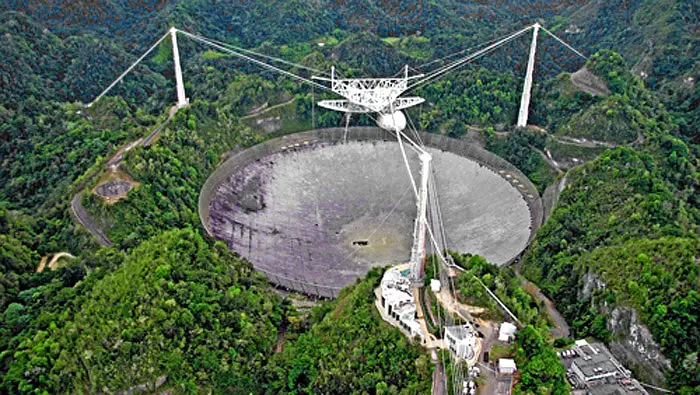Biggest telescopes in the world
Table of Contents
Science nerds love telescopes! They are buckets that collect light. And the bigger the bucket the more light they can collect! So, the biggest telescopes in the world are the biggest gatherers of light. And that is a whole lot of goodness! So let’s take a look at them!
The definition of “biggest” for a telescope is subject to a bit of interpretation. Some telescopes are made of a mirror ground from a single piece of glass. But even larger telescopes are composed of a honeycomb of smaller mirrors placed together to create a larger mirror. This type of telescope is called a segmented mirror telescope. A laser system is used to keep all the mirrors perfectly aligned so they act as one mirror.
And yet other telescopes are two or more mirror telescopes that work in tandem. With this type you can think of a pair of binoculars. This type of telescope can be operated as one telescope or they can be used individually.
What is the biggest telescope in the world?
The biggest optical telescope in the world is the Gran Telescopio Canarios. It is located at the Roque de los Muchachos Observatory on the island of la Palma in the Canary Islands, Spain. It is composed of 36 separate mirrors placed together to act as one mirror. It is 10.4 meters in diameter (409 inches).
The 36 mirrors are honeycomb shaped. When placed together they form an almost seamless single mirro . It is exactly like the cells in a honeycomb or a hexagonal dungeon map.
Take a look at these next three pictures of this telescope. And then we are going to look at another telescope that is significantly larger than this one but not an optical telescope so it doesn’t really count. But you might want to know about it.
Here is the dome that houses the telescope. The dome protects it from the elements and houses the astronomers, keeping them indoors while they work. To get a sense of how big this is you can see part of a two lane road just to the left of the white building. That big piece crossing the dome is a shutter. It slides open when they want to use the scope.

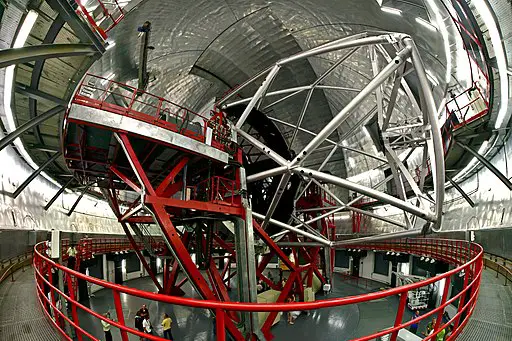
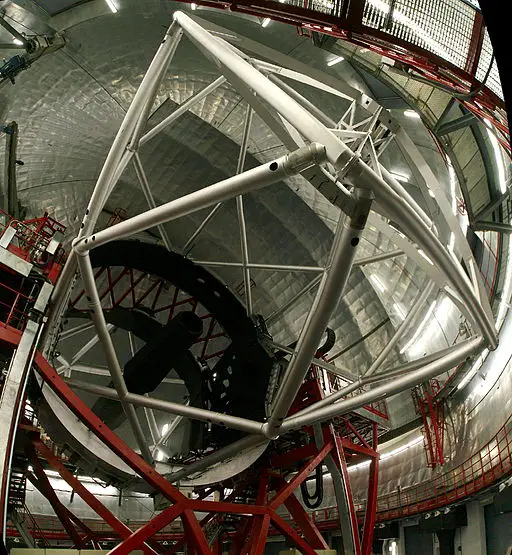
Interesting facts about the Gran Telescopio
- It has the light gathering power of four million times the average human eye.
- The primary mirror set weighs 17 tons and the whole moving telescope weighs 400 tons; yet, the engineering of it is so amazing well done that you can move the telescope with an easy push of your hand.
- It took 7 years to build
- It cost 130 Million Euros
- It has been used to observe and study a wide variety of celestial objects and phenomenon including objects within our own solar system, interstellar objects, dark matter, black holes and galaxies that at are the edge of our universe.
To learn more about the Gran Telescopio you can visit the official website here: The GTC Official Website And if you want to learn more about this telescope, take a tour of it, watch the youtube video I have at the bottom of the page.↓
But there are different types of telescopes. The Gran Telescopio is the largest optical telescope in the world . And by optical I mean it uses a mirror and sees things in the optical range just like our eyes see.
But there is another telescope in the world that is considerably larger and it only collects radio waves. That type of telescope is called a radio telescope. It is pretty much the same thing as a direct TV dish antenna but much much larger. Technically the largest one of this type of telescope is the RATAN-600 Radio telescope located in Zelenchukskaya Russia. It is a series of radio reflectors that form a ring that is 576 meters across.

It is a telescope. It just doesn’t fit into what we normally think of as a telescope. This next picture is of the Arecibo radio telescope. This one looks more like a telescope.
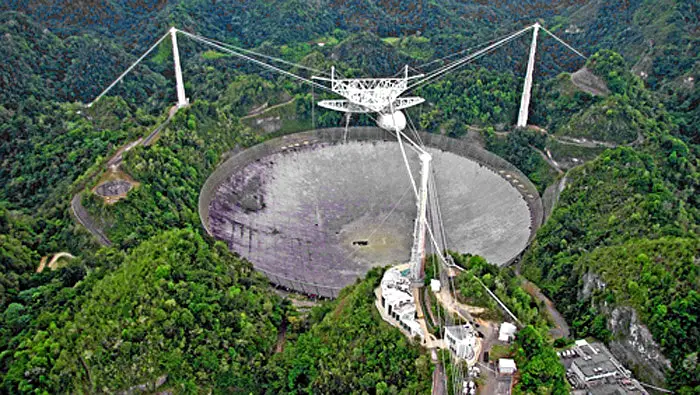
Okay, stick with me here a little bit longer because there is another telescope currently being built that is quite a bit larger than our Gran telescopio. It is an optical telescopes with mirrors and an astonishing feat of engineering.
The two Keck Telescopes
Keck 1 and Keck 2 – These two telescopes make up what is called the Keck Observatory. . Each telescope is a reflector with a mirror of 10 meters in diameter. They are located near the summit of Mauna Kea in Hawaii. The first one was completed in 1993 and the second in 1996. They were the first large telescopes to use a process called Adaptive Optics. It is a method of using a deformable mirror to correct for turbulence in the earths atmosphere. It is such a sensitive and accurate system that it can adapt and change the mirror 2,000 times a second. This is an unprecedented achievement and it allow the telescopes to capture images with ten times more clarity. The mirrors in the Keck telescopes are of the segmented type.
Hobby-Eberly Telescope Dome
Hobby-Eberly Telescope (HET)- It has a mirror telescope composed of 91 segments (effective diameter is 10 Meters.) This telescope is specially designed for spectroscopy which is the color spectrum you see when light passes through a prism. It is the project of two US universities and two German universities. And it is located at the Mcdonald Observatory in West Texas on Davis Mountain.
South African Large Telescope (SALT)
South African Astronomical Observatory in Sutherland South Africa. It has a 9.2 meter effective diameter segmented mirror and it went into service in 2005. An interesting design element of this telescope is that the primary mirror isn’t designed to fully track an object in the sky. This is done with the secondary element at prime focus. This had a significant cost reduction impact. Instead of the massive primary mirror having to be accurately moved the much smaller secondary unit is moved.
Large Binocular Telescope (LBT)
The Large Binocular – Mount Graham Observatory in Arizona. Each mirror has an effective diameter of 8.4 meters. Technically when these two telescopes are used in tandem they have a total effective aperture of 11.82 meters which technically makes the duo the largest telescope in the world. And each of the mirrors are a single piece of glass; they are not segmented mirrors like most of the others on our list. This makes them the largest single mirror telescopes in the world.
Subaru Telescope
At Mauna Kea in Hawaii (8.2 meter clear aperture) It is a single monolithic mirror, not segmented. It is operated by the National Astronomical Observatory of Japan and is named after the Pleiades – (Subaru is the Japanese name for the Pleiades). But it is not located in Japan. It is located at the Mauna Kea observatory in Hawaii right along side the two Keck telescopes.
The Very Large Telescope (VLT)
These next four make up what is called The Very Large Telescope or VLT: They are located at the Paranal Observatory in Chile. Each telescope has a monolithic (single piece of glass) mirror with a diameter of 8.2 meters and a clear aperture of 8 meters. The first of the four went into operation in 1998. The four telescopes are named:Antu, Keuyen, Melipal, and Yepun which are the names of celestial objects in the native Mapuche language.
Generally the four telescopes are used independently of each other for various research projects but occasionally they are used all in conjunction to observe the same object for research.
Some interesting terms we have learned:
- Monolithic Mirror – this is a large telescope mirror that is one complete piece
- Segmented mirror – This is a telescope mirror that is made of smaller hexagonal mirrors placed together
- AO or Adaptive Optics – An electronically controlled system that distorts a mirror as much as 2000 times a second to compensate for irregularities in the Earth’s atmosphere. It gives the telescope significantly better optical performance.
- Binocular telescope – two telescopes, side by side that can be operated together or independently.
- First Light – This is the term used for when a telescope is first used. It is usually first star light!
European Extremely Large Telescope
The European Extremely Large Telescope (ELT) The mirror is a honeycombed combination of mirrors just like the Gran Telescopio but it will be 39 meters in diameter compared to the 10.4 meters of the Gran Telescopio. That is a whopping difference.
It is currently being built and is scheduled to go live in 2025. It is located on the Cerro Armazones mountain in Chile’s Atacama desert. When this telescope goes live it will be the uncontested largest telescope ever built and it will hold that title for decades or longer because building a telescope like this takes decades! Preliminary work for this telescope began in 2000. Although that was a lot of conceptual work. It changed a lot in the following years and started to take it’s present form around 2006. That is still a good 20-25 years of development.
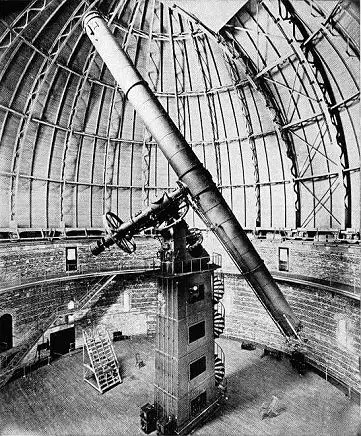 If you want to learn more about the ELT and check out the timeline of what has been done so far and what is next check out their website: The ELT Website
If you want to learn more about the ELT and check out the timeline of what has been done so far and what is next check out their website: The ELT Website
Let’s take a look at one more “Largest” telescope in the world. This is one of my favorites because it gives me a real sense of nostalgia. It is the Yerkes telescope. This telescope is different in that it doesn’t have a mirror or mirrors. It has a lens. And the lens is 40 inches in diameter which makes it the largest in the world for astronomical use. It was founded in 1897 and in 2018 it closed to the public. It’s future is currently unknown. There is a group trying to save it but what will happen is to be determined. It is located in Williams Bay Wisconsin and is part of the University of Chicago Dept of Astronomy and Astrophysics.
This type of optical telescope that uses a lens was a spectacle in its day. Nowadays we make large telescopes using mirrors. With mirrors we can achieve significantly larger telescopes. Lenses simply cannot be made much larger than 40 inches because the weight of the glass causes them to sag and distort!
Okay, our tour of telescopes has been an interesting one. We looked at the current largest optical telescope in the world (The GTC) which is our winner of the biggest. And we also looked at the largest radio telescope in the world. Then we covered the future with a telescope that in a few years will be the undisputed largest. Finally we looked at a telescope over 100 years old that at one time itself was the largest! But it used a lens which has strict limits in how large they can be built.
Telescopes in Space
- The Hubble Space Telescope (HST) – Is currently in service and in orbit around the Earth.
- The James Webb Space Telescope (JWST) ( planned) It is a segmented mirror telescope and it is scheduled to launch in 2021. And unlike the Hubble telescope the JWST will not orbit around the Earth. It will orbit around the sun and further out than the Earth. It is a 6.5 Meter telescope. This mirror is 2.5 times larger than the hubble and about 6 times larger in area.
- Kepler Space Telescope (KST) – Launched in 2009 – Kepler was specifically designed to look for planets in the habitable zone of stars in our area of the Milky Way galaxy. This telescope is now retired.
- Spitzer Space Telescope (SST) – It was launched in 2003 and is planned to be retired in 2020. It is an infrared space telescope.
Largest Refractor Telescope
The Yerkes Observatory 40 inches
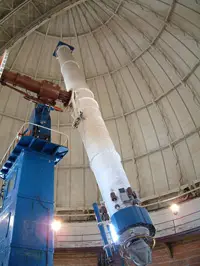 This is a refractor telescope with a lens rather than a mirror. It is the largest refractor telescope in the world and it’s future is in doubt. It closed to the public in 2018 and there is a group in the process of preserving it. It is located in Williams Bay Wisconsin and is part of the University of Chicago Dept of Astronomy and Astrophysics.
This is a refractor telescope with a lens rather than a mirror. It is the largest refractor telescope in the world and it’s future is in doubt. It closed to the public in 2018 and there is a group in the process of preserving it. It is located in Williams Bay Wisconsin and is part of the University of Chicago Dept of Astronomy and Astrophysics.
Largest Radio Telescopes
- RATAN-600 Radio telescope in Zelenchukskaya Russia
- FAST – Five Hundred Meter Aperture Spherical Telescope
- Arecibo in Puerto Rico (picture below)
